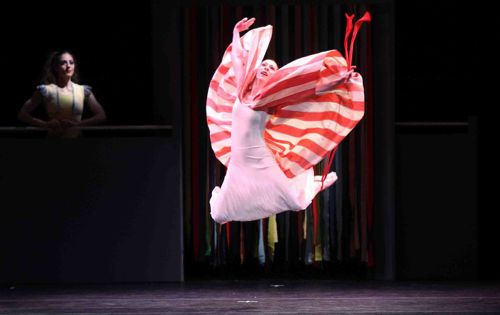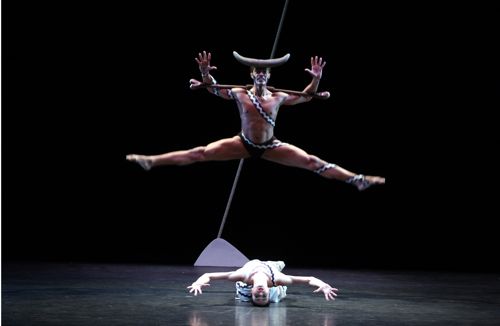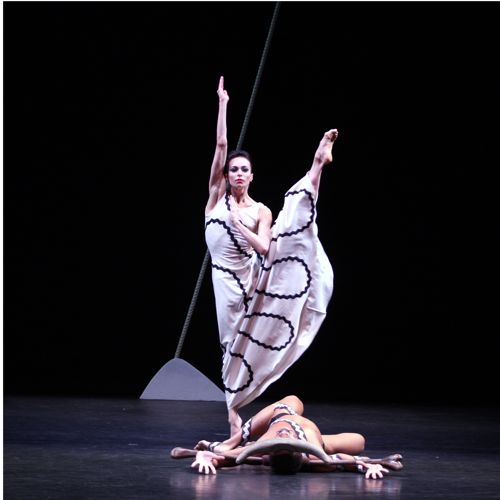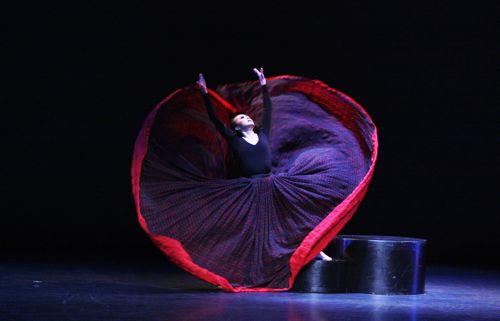Martha Graham Dance Company / Joyce Theater, NYC, and City Center, NYC / March 13 – 18, 2012
Martha Graham, performing Lamentation (courtesy YouTube)
Everything that lives must die, as a colleague explained gently to her very young daughter, when the child was wrestling for the first time with the idea of death. The idea is also applicable to even the most glorious dance institutions, such as the Martha Graham Dance Company, on view for a week at the Joyce Theater.
I saw the first of the two ordinary repertory programs offered. It opened with a murky, jittery video collage—meant, as company director Janet Eilber likes to say, to “contextualize” the live dancing that would follow. Eventually.
Mary Wigman, performing Witch Dance (courtesy YouTube)
The live stuff began with Mary Wigman’s 1926 Witch Dance, in homage to Graham’s legendary predecessor in the realm of Expressionist dance. Actually Graham was pretty much sui generis, but let that pass. The raw solo for a masked woman in picturesque rags is composed of terrifying crazed moves occasionally gentled by a phrase of fleeting, meditative sensuousness such as the hand stroking the cheek. PeiJu Chien-Pott made a good, if dutiful, job of it.
The program moved on to Graham’s own work with the 1939 Every Soul Is a Circus, which borrows its name from a Vachel Lindsay poem. The dance is a rare instance of this choreographer’s aiming for comedy—or, at least, satire. Graham’s subsequent work would prove that she was instinctively tragic, dramatic, and melodramatic, an artist who looked deeply into the human condition and was not amused.
 Blakeley White-McGuire as the Empress of the Arena in Every Soul Is a Circus
Blakeley White-McGuire as the Empress of the Arena in Every Soul Is a Circus
Photo: Costas
In Circus the Empress of the Arena is Graham herself. When she flings herself onto her couch, hysterical because she can’t transform her vision into reality, she’s behaving as history records Graham doing in real life. The Empress is relentlessly observed by the Ideal Spectator, a motionless (and noncommittal) woman, and courted by a sturdy, take-charge Ring Master (Tadej Brdnik, originally Erick Hawkins) and a buoyant Acrobat (Lloyd Knight, originally Merce Cunningham in his first role with the troupe). The ensemble is represented by five jeunes filles en fleur in pretty pastel dresses—one already successfully working her way to stardom. Their stage is a mid-century (20th) toy theater, with nothing more substantial than sparse furniture that resembles playthings, while red ribbons and a swath of red cloth indicate proscenium and curtain. This is a world created from nothing, Graham proposes, and the Empress is so foolish as to assume she can make high art out of it. Of course, in real life, she did.
Unfortunately Circus falls flat today—some quarter-century since it was last performed—largely, I suspect, because its current audience is not steeped in the heady Graham legend, and partly because Blakeley White-McGuire is unconvincing as the Empress.
Night Journey, with Graham as Jocasta (courtesy YouTube)
Night Journey, from 1947, the most important dance on the program, suffered from the same inadequacy of casting. Looking at Katherine Crockett, as statuesque, beautiful, and impassive as a fashion mannequin (heaven-sent as the woman in white in Diversion of Angels), it’s almost impossible to imagine her as Jocasta, doomed to mate unwittingly with her son, who—well, you know the terrible tale. This problem of casting against the grain arises repeatedly now because the company no longer commands enough dancers of the highest caliber to take on Graham’s leading roles appropriately. (This is ironic, since Graham originated almost all of them herself.)
At any rate Crockett worked hard to inhabit her role and, by the midpoint of the dance, she had become convincing—in her erotic desire, in her intimation of the curse and the resultant sin that would destroy her, and finally in the horror of her situation as it was finally revealed, a situation to which suicide was the only solution.
I can’t help wishing that the celebrated seven-woman Chorus—a leading character in itself—had been even keener in its unison and thrust. It still registered as a highlight of the choreography, as did the motherly gestures, including a pietà pose, of Jocasta toward Oedipus in the course of their erotic duet.
I’m making no comment on Lamentation Variations because the very idea behind it—inviting other choreographers, mediocre ones, more often than not, to do a gloss on Graham’s singular achievement—seems to me a desecration of the original, which happens to be perfect.
 Diana Vishneva, with Abdiel Jacobsen, in Errand Into the Maze
Diana Vishneva, with Abdiel Jacobsen, in Errand Into the Maze
Photo: Costas
The day after the opening the company moved uptown to the more capacious City Center for its gala. Featuring the Russian ballerina Diana Vishneva, the evening was likely to attract a larger audience. Partnered by Abdiel Jacobsen, Vishneva danced one of Graham’s landmark works, the 1947 Errand Into the Maze, a duet about conquering fear, based on the Greek myth of Ariadne and the Minotaur. Vishneva had already had a big hit with it in her homeland.
A number of prominent ballet dancers have, in their time, attempted to dance Graham’s works. I recall with dismay Margot Fonteyn (sweet and dutiful) and Rudolf Nureyev (irresponsible) and the Blackglama “What Becomes a Legend Most?” ad that promoted their misalliance with Graham. Classical ballet technique and the vocabulary Graham invented are two distinctly disparate languages, each taking years to master and leaving their impression on a dancer’s anatomy and posture and how she instinctively—incontrovertibly—moves. So I was astonished to see that, to a remarkable degree, Vishneva brought the task off.
 Vishneva, with Jacobsen, in Errand Into the Maze
Vishneva, with Jacobsen, in Errand Into the Maze
Photo: Costas
A vulnerable-looking woman (all of Graham’s chief protagonists are female) contends, three times, with a brute creature (half man, half beast) who fills her with an unspecified but all-pervasive terror. Twice she drives him away; the third time she drives him away for good and retreats to her Noguchi-constructed home base and removes the rope that once barricaded it, opening the door, so to speak, to an unhampered life.
I think Vishneva was convincing because she operated here just the way she does, to great acclaim, with her classical-dance roles, leaving nothing to impulse or chance, but investigating exhaustively what is required and figuring out how to produce it. Her tenacity is a marvel. Granted she hasn’t quite mastered the whiplash energy typical of a Graham dancer and she’s not best buddies with staccato timing, so some of the choreography is smoothed out. But she understands her material and, I think, respects it. This wasn’t merely a star turn.
Photo: Costas
Fang-Yi Sheu, once an unforgettable star with the Graham company, returned for the occasion as a guest artist in the 1936 Chronicle. A powerful dance for 12 women used chorally, with the figure Sheu played as instigator and inspiration, it’s a striking metaphor for the power of women in the face of war and desperate poverty. Sheu’s technique has understandably diminished but she’s as theatrically compelling as ever. In this role she exudes a saintly charisma. Who wouldn’t take action at her behest? I felt ready to execute the hundred jumps the chorus is said to perform or, more realistically, the community-service equivalent of same.
A small but delightful curtain raiser to the main events was the duet from Appalachian Spring, performed by the two best dancers in the company, Miki Orihara (as The Bride) and Tadej Brdnik (as The Husbandman). The pair fit their characters well, danced with touching attention to detail and the authenticity achieved through an in-depth familiarity with the piece. The performance closed with Diversion of Angels—the sole major Graham work that presents happiness undiluted. Lloyd Knight stood out here, as he does in everything he dances.
During the two evenings that I watched the present-day version of Graham, I saw to a heartbreaking extent how her company has diminished—not just in first-rate dancer power, but in astute direction, public popularity, and (apparently) funding. Yet seeing a few of Graham’s greatest works, even under far from ideal circumstances, I felt more convinced than ever that these treasures should survive and be properly performed. Still, for the life of me, I can’t see how that is going to happen.
© 2012 Tobi Tobias





Thank you.
Tobi, as always, I appreciate your scholarship, insights, and marvelous prose. When I read through, my heart hurt a bit, as it always does these days when I hear comments from people who rarely if ever saw the woman dance, let alone her stunning teaching (in her good days). I’m going on 8 decades and the first two of them (starting at around the age of 7) were in some way connected to Martha — in the concert halls, at the studio, ultimately in the “June” NYC course where she encouraged me to come to the summer program at Connecticut College. I had asked her if she thought I “had it” to become a dancer, and she promised to tell me at the end of her stint, when she said yes, I’d be a good dancer. However, I went back to Oberlin, treasuring all the modern dancers, Bob Cohan, Martha’s assistant teacher, and yes, Paul (Pete) Taylor in his first year, too. What a time we had!
I kept dancing for years at the Graham studio and the New Dance Group, going to Martha’s concerts (and watching Paul and the others dance brilliantly for a number of years with her). I even went dutifully to the concerts she shouldn’t have danced in. Then came the inevitable slide and the rest is history.
Here is my “conclusion”: The only dancers who have done honor to Martha’s work are those who studied with her, danced with her, and understood her very clear and innovative dance theory and practice and its connections to animals (always when teaching), life, love, passion, clarity, energy, and commitment to the “story.” There have been some dancers who absorbed her technique, world view, and dedication; most (though not all) of them are gone. I quit going to the Graham company’s concerts about five years ago; it hurt too much to see people with good will and insufficient skill trying to do what a once in a lifetime lady did. For me there’s only one Jackie Robinson, one Elisabeth Schwarzkopf, one Balanchine, one Paul Taylor, one Magic Johnson, and one Mozart. ‘Nuff said.
IN RESPONSE TO JANE REAMER:
While you have a point about those who had a connection to the real thing, which I did also but a bit later, I think with the right training and coaching a good performance is possible of some very great work. I feel sad when I see a program that doesn’t make it but sometimes I am moved. I have also commented on Tobi’s article and plan to make my own comments this year, if not publicly then privately. It’s only fair to say there are many great Hamlets and right now there is a great Willy Loman. I’ve seen “Lamentation” and “Medea” with Martha, and some in the roles since have stirred me. Wouldn’t it be too bad if the best of Martha’s dances were never to be seen again?
I was reluctant to read any reviews of the MGDC season until after I saw the two programs (A and B) for myself this weekend. However I was motivated by your take on the Gala Program and your take on what I will not see.
I think I can agree with almost everything you wrote: Diana Vishneva’s serious attempt to take on the role, Fang-Yi Sheu’s former star power in Graham roles, Lloyd Knight’s superb dancing, and Miki Orihara’s position as “best” now. I also think you last paragraph rings true.
On Wednesday March 14th I had the pleasure of seeing the “University Partners” performing important works from the Graham repertory along with an early dance by Charles Weidman. I came away thinking there is hope for a future, if not for a star- powered company but for a generation of dancers changed by the privilege of performing these dances. All were taught and coached by former Graham dancers who maintained the integrity of the choreography and the spirit behind it. I played a role in arranging for the Labanotation of “Heretic” as I am now on the staff of the DNB. I can’t think of a better way of learning about dances of historical importance than having opportunities for them to be staged and performed. I know the evening was a success on many levels and I think something similar will be done again.
I’ll be happy to share my opinions with you again after I see both programs this weekend.
Tobi,
I so rarely disagree with you, but reading your review of MG’s gala I have to. I thought Vishneva was an absolute disaster in “Errand.” She could not do anything right technically, did not connect with the Minatour at all, and faked so many of Martha’s signature technical moments such as knee vibrations, knee crawls, and the shuddering contractions that should scare the wits out of the audience. She rendered the pitch turns as arabesque turns with a dip at the end. I could go on and on. It almost broke my heart to watch. I had feared the worst and was not disappointed, unfortunately. I thought the performance was a disgrace to a great ballerina and a great modern dance technique in one fell swoop. I can admire Vishneva’s interest in Graham and her wanting to learn about other styles and techniques, as Baryshnikov did, but that does not give her the right to perform them as if she has conquered them. Graham and ballet take the same 10 years of study if one wants them to be “good” for starters, not 10 weeks, or days.
Disappointed? Not really. Angry? Very.
In the summer of 1959 it seems to me, I went with you, Tobi, to watch Graham teach class at her studio in the town house, long before I entered the lucrative profession of writing about dancing. (I was in those days a visual arts critic.) In 1961 it came to pass that the first dance review I wrote was of “Clytemnestra,” with Graham in the title role. On that summer morning, I was fascinated to watch Graham, a well-known figure during my Village childhood, focusing for an hour and a half on “the neck.”
Many years later, ten years ago in fact, very shortly after my husband died, I was asked by the National Endowment for the Arts to report on the Graham season at the Joyce, I think the first full season they had following the Ron Protas kerfuffle. “Lamentation” was on the program, performed by a thoroughly committed dancer, and you were right, Tobi, it’s perfect. As is in my view “Cave of the Heart,” but not the last time I saw it performed, here in Portland a couple of years ago.
The repertoire is now approached so clinically, and so didactically, that the mind/body connection from which Graham made her art is lost. I think the direction of the company now is godawful, and what might, might, possibly save some of this work, is someone who trusts the audience to respond to Graham’s work as art rather than history. Who that might be, I have no idea.
Great piece; I had very similar feelings.
Your column is excellent, and it’s great to learn that Vishneva did so well. Remember that Plisetskaya also performed with the company? (St. Denis’s “Incense” solo, wasn’t it?). I can’t bear, though, to write a comment on this one. Not only was Wigman, herself, not in rags for “Witch Dance”–she was (as she says in a fascinating documentary on her, from the early 1950s, maybe) wearing an especially beautiful jacket from the Orient. I think she even says that the entire dance came about because the jacket was so beautiful, and she wanted to showcase it! This is what my (too-often fallible) memory recalls, anyway. If I can, I’ll watch the doc in the next few days and will write again if I’ve misremembered.
Only been to the gala at City Center so far. Love Orihara in anything. Thought “Diversion of Angels” kind of sad. Actually enjoyed “Chronicle” a lot; how Graham was going to unleash her army of Bennington girls to march over the Atlantic and beat up Hitler. Vishneva should’ve chewed the scenery more; she’s not a Graham dancer and can only fake it. If over-the-top is the biggest arrow in your quiver, you shouldn’t be afraid to use it. That and her cheekbones.
I love the unironic presentation of powerful heroines, unabashed emotionalism, and also that Graham expected people to have at least a bit of a Classical education.
So much dance these days is about form and process and recursive navel-gazing about the making of itself, it’s a joy to see dance that wants to matter.
Thank you!
IN RESPONSE TO MINDY ALOFF ON THE COSTUME FOR “WITCH DANCE”:
About eight years ago, Kansas City Ballet did a reconstruction of Wigman’s “Witch Dance,” and Mindy is absolutely correct–it was done in a beautiful Asian-looking jacket, performed by Kimberly Cowen, who had been given a few hints by Todd Bolender (he had seen Wigman dance the piece in New York in the early Thirties). A young boy sat in front of me in the Kansas City audience; he was absolutely terrified. It was a wonderful performance; I can’t say if it was faithful to the letter of the original, but it was sure as hell faithful to the spirit.
I saw one of the programs by the Graham company this evening which opened with “Witch Dance.” Tobi, the costume, at least tonight, wasn’t “picturesque rags” at all. It was a rather beautiful claret-colored velvet or velveteen one-piece draped garment, with a kind of floral pattern silkscreened on the front. It wasn’t the garment that Wigman wears, but it was a beautiful costume. The performance was also close to the movement that Wigman does in the film, although the dancer, tiny and light, had a different presence, a dancey presence, where Wigman–weighted, and, to use your word, “raw”–was beyond dance: She was terrifying.
To follow up on Tobi’s comments now that I’ve seen both programs and read or heard what others said about the Gala:
I think Vishneva was a vehicle for selling tickets but I really appreciate what Alastair wrote about her in today’s NYT. I thought the Joyce performances were an improvement over last year’s. The dancing looks stronger.
My least favorite dance was “Every Soul….” It wasn’t a bit funny and I found it boring. I believe I thought the same thing when I saw a revival at BAM many years back, so I can’t blame the current dancers. “Deaths and Entrances” was a bit better this year, though I still had issues about the costumes and casting. It seemed less boring and not as long.
The Lamentation Variations had some high points and some flat effects too. Though I enjoyed the humor in Yvonne Rainer’s variation, it didn’t really have a place there. I still like Pagarlava’s best and maybe Lar Lubovich second. I was curious to see Janet Eilber’s role in the Rainer but she could have been given better material beyond the shredding.
So is better anything like good enough? The company dancers are clearly more professional than the university/schools dancers but the works staged for educational purposes looked more hopeful for MG after Martha.
Just finished reading your Graham write-up and wanted to let you
know . . .
You are so good! I love reading your words–especially those of a descriptive nature. Sometimes they send me to the dictionary for their meaning and I find that you always nail it beautifully.
Thank you for all of your dance criticism.
About the Graham company’s policy of “contextualization”: It galls me no end that the language of dance, and from one of its most eloquent and original speakers, is not deemed sufficient to carry a performance. When I go to the theater, I pay for and expect an evening of theater, an experience beyond words. The program must not attempt to move me through logic, rational argument, or recitation of fact. It must move me as ART.
If I want to know ABOUT dance I will take a course, read a book, attend a lecture. If I want to experience the art form of theatrical dance, I attend a PERFORMANCE, in a THEATER. It is akin to religion.
I wonder what it would look like if the Graham company committed itself to really communicating the work through dance rather than verbiage and half-baked marketing ploys. Does the direction not trust the efficacy of Martha’s work to be able to do that? Clearly we now have evidence that if the dancing is not doing that, then no amount of talking, explaining, and hyping can salvage it. The only thing to do is to get the dancing working as it should.
Since the Graham organization chooses to give top billing to the Executive Director over the Artistic Director, it is probable that artistic decisions are based on the same hierarchy. That is very sad, indeed.
Someone, please, either resuscitate this company or let it go with some semblance of its original dignity and elegance. Merce was wise to see this and avoid it for his own company.
In response to the Devoted Reader’s comments, I agree completely that Graham’s works should not need contextualization except perhaps in program notes similar to those provided at an opera performance. The first time I attended a performance with explanations offered before a Graham dance I was at a free Damrosch Park performance one August. Since I could barely see the stage anyway I dismissed the whole experience as frustrating. The next time was in Saratoga where the MG company gave a one-night-only performance in June. While I thought the explanation totally unnecessary for my own use, I met others that night who thought it was fine. The theater was full and the crowd seemed enthusiastic. Since then I’ve kept my true feelings of disappointment and anger to myself and to friends and colleagues. I think an educational mission has its place, but not in the theater.
A wonderful piece on a company almost reduced to history. I still remember seeing these pieces performed in New York in the late 1980’s when Graham was still alive. They were extremely moving. But I think to a contemporary audience these pieces must be like us watching Isadora Duncan. You know that she revolutionitzed dance, it just looks so old-fashioned. In Graham’s case, at least we have the video clips and our memories.